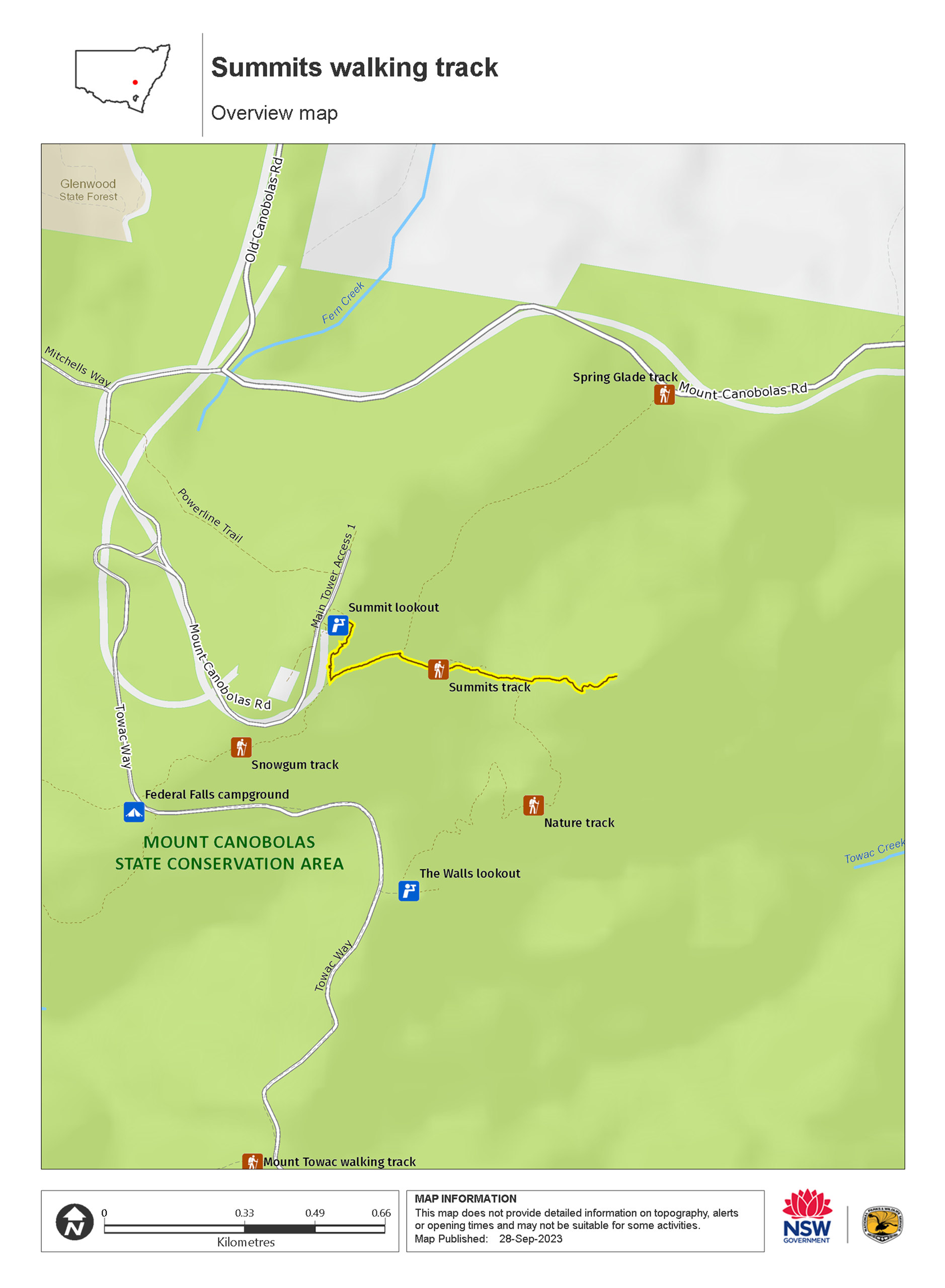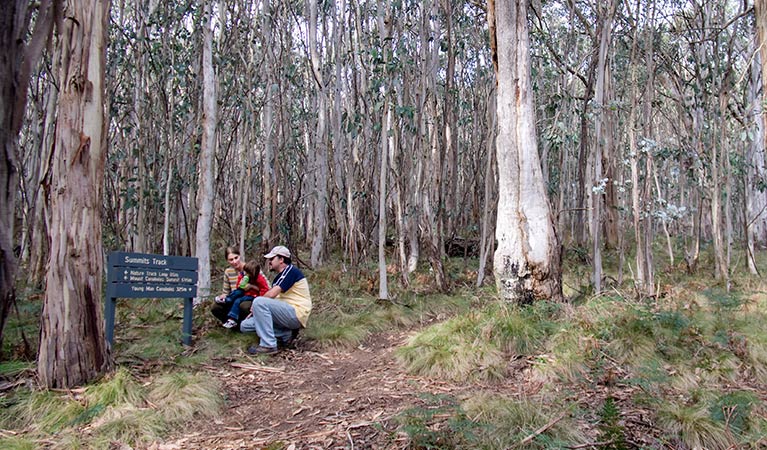Overview
Summits walking track joins the two of the peaks within Mount Canobolas State Conservation Area. Walk it as a short walk or longer day walk, enjoying scenic views and birdwatching.
- Distance
- 2.1km return
- Time suggested
- 45min - 1hr 15min
- Grade
- Grade 3
- What to
bring - Hat, sunscreen, drinking water
- Please note
- Because of the altitude, the weather can change quite quickly. You should always check the weather forecast before setting out for a walk. It's advisable to bring a jumper with you, and in winter always bring a raincoat and warm clothing.
- Spring Glade, Snowgum and Nature walking tracks connect with Summits walking track – look for signage along the way
- Remember to take your binoculars if you want to bird watch
Summits walking track connects two of the park’s summits, Mount Canobolas (also known as Old Man Canobolas) and Young Man Canobolas, traversing a saddle between to two mountains and joining up with some of the other walking tracks along the way.
Before you head off on the walk, take some time to admire the scenic view from Summit lookout, at the peak of Old Man Canobolas. You'll be able to see the town of Orange and surrounding countryside.
When you’re on your way, you’ll first hike along a downhill track that passes through snowgum grassy woodland. Keep an eye out for grey currawongs during summer and look for white throated tree creepers. From there, you’ll wind uphill to the summit of Young Man Canobolas.
If you’d like to turn this short walk into a longer day walk, you can join up with the Spring Glade, Snowgum or Nature walking tracks. Look out for signage along the way.
Also see
-

Summit lookout
Summit lookout in Mount Canobolas State Conservation Area is the highest peak in central-west NSW and offers stunning views. Just 18km from Orange and easy to get to, it’s ideal for a quick trip.
-

Nature walking track
Nature walking track is an easy walk for anyone wanting to explore the natural beauty of Mount Canobolas, offering birdwatching and wildflower displays in spring.
-

Spring Glade walking track
Spring Glade walking track provides easy access to the summit of Mount Canobolas via a pleasant easy walk through grassy woodland, offering birdwatching and picnic opportunities.
-

Snowgum walking track
Snowgum walking track is short and easy, it starts from the summit of Mount Canobolas or from Federal Falls campground. It’s a great way to work up a hunger for a barbecue lunch.
Map

Map legend

Local alerts
For the latest updates on fires, closures and other alerts in this area, see https://www.nationalparks.nsw.gov.au/things-to-do/walking-tracks/summits-walking-track/local-alerts
General enquiries
- National Parks Contact Centre
- 7am to 7pm daily
- 1300 072 757 (13000 PARKS) for the cost of a local call within Australia excluding mobiles
- parks.info@environment.nsw.gov.au
Park info
- in Mount Canobolas State Conservation Area in the Country NSW region
Mount Canobolas State Conservation Area is always open but may have to close at times due to poor weather or fire danger.
Visitor info
All the practical information you need to know about Summits walking track.
Track grading
Features of this track
Distance
2.1km return
Time
45min - 1hr 15min
Quality of markings
Clearly sign posted
Experience required
No experience required
Gradient
Short steep hills
Steps
Many steps
Quality of path
Formed track, some obstacles
Getting there and parking
On entering Mount Canobolas State Conservation Area, follow Mount Canobolas Road all the way to the summit of Mount Canobolas.
Road quality
Roads may close when it snows (generally once or twice each winter).
Best times to visit
There are lots of great things waiting for you in Mount Canobolas State Conservation Area. Here are some of the highlights.
Autumn
Wake up to misty mornings and enjoy clear, sunny skies – it's a magical time of year to visit.
Spring
See the violet kunzea, fringe myrtle and mirbelia flowers blossoming in the heaths around rocky outcrops.
Weather, temperature and rainfall
Summer temperature
Average
13°C and 26°C
Highest recorded
36.7°C
Winter temperature
Average
0°C and 8°C
Lowest recorded
-3.3°C
Rainfall
Wettest month
August
Driest month
March
The area’s highest recorded rainfall in one day
124.2mm
Facilities
Picnic tables are available at The Walls picnic area, the starting point of the Nature walking track.
Maps and downloads
Prohibited
Pets
Pets and domestic animals (other than certified assistance animals) are not permitted. Find out which regional parks allow dog walking and see the pets in parks policy for more information.
Smoking
NSW national parks are no smoking areas.
Learn more
Summits walking track is in Mount Canobolas State Conservation Area. Here are just some of the reasons why this park is special:
An Australian menagerie

Mount Canobolas has an abundance of native animals which thrive in this special environment. Around 950 species of plants and animals have been recorded in the park, including several species that exist nowhere else in the world. Thornbills, treecreepers, flame robins, wrens and honeyeaters, as well as good old magpies, currawongs, rosellas, kangaroos and wallabies call Mount Canobolas home. Threatened and endangered species like the antechinus marsupial mouse and silver-leaf candlebark can also be found in the area. When the sun goes down, grab your torch to spot the many possums and wombats, all the while being serenaded by the southern boobook owl.
- Snowgum walking track Snowgum walking track is short and easy, it starts from the summit of Mount Canobolas or from Federal Falls campground. It’s a great way to work up a hunger for a barbecue lunch.
- Spring Glade walking track Spring Glade walking track provides easy access to the summit of Mount Canobolas via a pleasant easy walk through grassy woodland, offering birdwatching and picnic opportunities.
Ancient connections

Mount Canobolas State Conservation Area incorporates the traditional land of the Wiradjuri People. The name Canobolas comes from the Wiradjuri words Gaahna Bulla meaning two shoulders, referring to the two main peaks, Old Man Canobolas and Young Man Canobolas. The area has a strong Aboriginal connection as an important place for male initiation ceremonies and stone tool making, as well as being a rich source of food and medicines. Find out more about this area's Aboriginal heritage at Federal Falls campground.
- Summit lookout Summit lookout in Mount Canobolas State Conservation Area is the highest peak in central-west NSW and offers stunning views. Just 18km from Orange and easy to get to, it’s ideal for a quick trip.
Outstanding landscapes

Now extinct and with a violent past, Mount Canobolas was an active and aggressive volcano responsible for creating the landscape between 11 and 13 million years ago. The result? Mount Canobolas State Conservation Area boasts vents, dykes, peaks and plugs which all can be seen here and the large rocky outcrops are home to rare lichens, towering basalt cliff lines and impressive waterfalls. The high altitude, cool climate and moist environment make this fertile ground for more than 300 plant species in the region. Large areas of snow gum subalpine woodland, grassy woodland and rocky outcrops covered with a variety of mosses and lichens make this a great place to visit. It’s hard to say what is most beautiful here, but certainly the heaths in spring which burst with purple, white, yellow and red flowers are a sight to behold.
- Mount Towac walking track This short walk will take you to Towac Peak where you can enjoy panoramic views of Mount Canobolas State Conservation Area and the scenic countryside of Orange.
Rising from the ashes

Mount Canobolas is recovering strongly from devastating fires that burned nearly 70% of the state conservation area in 2018. NPWS staff is working with the Orange Field Naturalist and Conservation Society to monitor, audit, and survey plant vegetation communities, insect and animal species, and Aboriginal sites. The park’s after-fire monitoring and conservation program has increased the number of known plant and animal species in the park, including discovery of 2 new ground orchid species new to science and rediscovery of 2 orchids unseen for over 20 years. As animals return, trees sprout new growth and plants come back there’s hope for the recovery of our native plants and animals.
Plants and animals protected in this park
Animals
-

Superb fairy wren (Malurus cyaneus)
The striking blue and black plumage of the adult male superb fairy wren makes for colourful bird watching across south-eastern Australia. The sociable superb fairy wrens, or blue wrens, are Australian birds living in groups consisting of a dominant male, mouse-brown female ‘jenny wrens’ and several tawny-brown juveniles.
-

Common ringtail possum (Pseudocheirus peregrinus)
Commonly found in forests, woodlands and leafy gardens across eastern NSW, the Australian ringtail possum is a tree-dwelling marsupial. With a powerful tail perfectly adapted to grasp objects, it forages in trees for eucalypt leaves, flowers and fruit.
Environments in this park
General enquiries
- National Parks Contact Centre
- 7am to 7pm daily
- 1300 072 757 (13000 PARKS) for the cost of a local call within Australia excluding mobiles
- parks.info@environment.nsw.gov.au
Operated by
- Bathurst office
- Monday to Friday, 8.30am to 4.30pm.
- 02 6332 7640
- 02 6332 7680 To contact the KARST Conservation Unit in this office.
- npws.centralwest@environment.nsw.gov.au
- Level 2, 203-209 Russell Street, Bathurst NSW 2795
Park info
- in Mount Canobolas State Conservation Area in the Country NSW region
Mount Canobolas State Conservation Area is always open but may have to close at times due to poor weather or fire danger.

